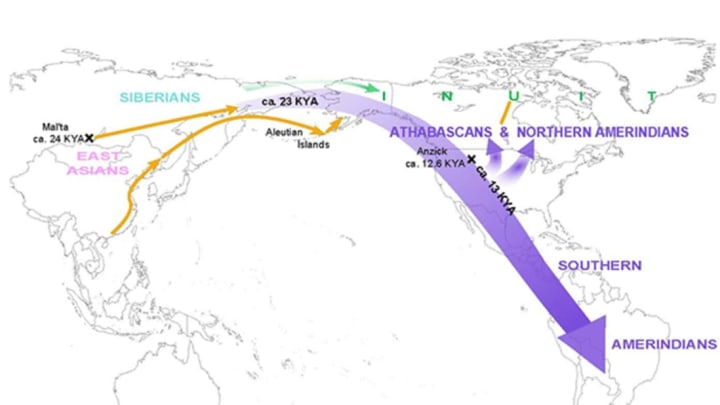People arrived in the Americas relatively later than on other continents. The oldest evidence for anatomically modern humans in Asia comes from bones that are at least 46,000 years old, for instance, while the oldest archaeological evidence for people in the Americas, found in Chile, is only 15,000 years old.
Two new scientific papers provide new information about how people migrated to North and South America thousands of years ago, one that indicates that humans migrated in a single wave from Siberia 23,000 years ago, and one that finds evidence for a genetic link between some Amazonian peoples and indigenous Australians and islanders from southeast Asia.
In a study published in the journal Science, an international team of researchers led by the University of Copenhagen analyzed the DNA of contemporary Native American and Siberian populations and compared their genetics to genetic data taken from ancient Native American DNA dating back 200 to 6000 years ago, including some from the ancient Washington state resident known as Kennewick Man.
They determined that all Native American populations descended from a single migration wave across the Bering Strait and into the Americas as long as 23,000 years ago, though there was a later wave of migration that established Eskimo and Inuit populations in the Arctic. The genetic split between North and South American populations might have occurred around 13,000 years ago.
"Some of the most important questions people ask are: Who are we? Where did we come from?" study co-author Michael Crawford, an anthropologist at the University of Kansas, says. "Now, thanks to genetic analysis, the picture is clearer for Native Americans: They came from Siberia."
However, the picture may not be quite crystal clear. “At the same time, we see surprises including genetic signals of East Asians and Australo-Melanesians, presumably coming in after the first migration wave,” study author Eske Willerslev of the University of Copenhagen explains in a press release. Those genetic signals are discussed in a separate study published in Nature this week, which claims genetic evidence for a link between some indigenous Amazonian populations and people from southeast Asia and Australia. The analysis, led by Harvard Medical School geneticists, shows that two groups who currently live in the Amazon are more closely related to indigenous populations of modern Australia, New Guinea, and the Andaman Islands than to contemporary Eurasian or Native American populations.
The two groups have diverging hypotheses about how this Australian DNA got mixed into American populations. The University of Copenhagen-led research points to Australasian ancestors arriving in the Americas less than 9000 years ago, while the Harvard group argues that the Australasian ancestors of the Amazonians came to America along with the first migration, but that this Population Y was later wiped out and replaced by other genetic populations.
It’ll take a lot more research to sort out the mystery of the strange Australian genes in South America, but at least now we know that humans have been wandering around the Americas for some 20,000 years.
